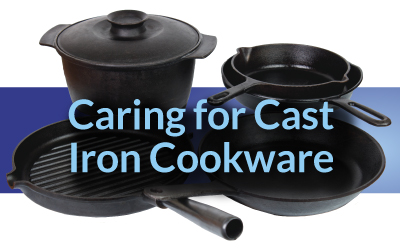
Ah, the cast iron skillet. Your grandmother swore by it as the best way to sear a steak or make crispy hash browns. Now that you’ve inherited her precious cookware, you’re too intimidated to use it. Hidden at the bottom of the pan drawer, it’s out of sight where you don’t have to think about all those rules of care you’ve heard. How does one “season” a skillet, anyway?
Caring for cast iron is far easier than you might think, say the pros at Lodge Manufacturing, the authority on the subject. Craftsmen have been making versatile, heavy-duty cast iron skillets since 1896 at the company’s foundry in South Pittsburg, Tenn., just north of the Georgia state line.
With the help of Lodge and reliable sources, Walton Gas has compiled this helpful Q & A for using and maintaining your cast iron cookware. So, go ahead and pull out that skillet, which will probably require two hands to lift. Combine it with the precise heat control of a natural gas stove to prepare food to perfection – just the way grandma used to do it.
Q: What does “seasoning” mean?
A: Cast iron “seasoning” is the process that occurs when multiple layers of oil bake into cast iron cookware, creating a rust-resistant and nonstick surface. Most new cast iron cookware comes pre-seasoned, also called factory or foundry seasoned. An older skillet that hasn’t been properly maintained may need to be cleaned and re-seasoned.
Q: How do I “re-season” cast iron cookware?
A: First, wash the cast iron in hot soapy water, scrubbing vigorously to remove residue and a layer of old seasoning. Dry it completely (inside and out). Next, using a small amount of vegetable oil, wipe down the cookware, inside and out. Wipe away all of the oil so that the pan appears to not have been oiled in the first place. Be thorough in wiping away oil to prevent having “sticky” cookware. Place oiled cast iron in a 450 F oven for 30 minutes. Repeat the process (oiling, wiping and baking) three or four times to achieve a good “seasoned,” nonstick surface.
Q: What’s the best way to clean cast iron cookware?
A: According to Lodge, follow these three steps to clean your cookware: 1. Wash your cast iron cookware by hand. You can use a small amount of soap. If needed, use a pan scraper for stuck-on food. For stubborn, stuck-on food, simmer a little water for 3-5 minutes, then use the scraper after the pan has cooled. 2. Dry promptly and thoroughly with a lint-free cloth or paper towel. 3. Rub a very light layer of cooking oil onto the surface of your cookware. Use a paper towel to wipe the surface until no oil residue remains. Remember: The more often you use your cast iron cookware and clean/dry/oil it, the more non-stick it becomes.
Q: Can I use soap to clean cast iron cookware?
A: The pros at Lodge say soap isn’t necessary, but you can use mild dish soap to clean cast iron. Factory seasoning is fairly resilient and can withstand a little bit of soap, water and a good scrub with a brush.
Q: Is it OK to use steel wool to scrub stuck-on food?
A: Avoid using steel wool on cast iron. Instead, use a gentle brush or plastic scrapper to remove stuck-on bits. If rinsing and gentle scrubbing aren’t enough, pour a few tablespoons of canola oil and a few tablespoons of kosher salt into the pan and use a paper towel to scrub the pan with this mixture until it comes clean, then rinse.
Q: Should I wash a new cast iron skillet before using it the first time?
A: Yes, a little mild dish soap and water should be used for a first wash to remove factory residue or rust bits. This light rinse won’t damage the factory seasoning. Make sure you rinse and dry the pan well before storing.
Q: If it rusts, is my cast iron ruined?
A: Nope! Rust happens, but it can be easily removed. Simply scrub the area with steel wool and follow the steps to re-season your cast iron pan. To prevent rust from returning, dry cookware promptly after each use, and finish with a light layer of cooking oil.
Q: What’s the best way to store cast iron?
Make sure your cookware is bone dry before you stack it or hang it. Rust is the enemy of seasoning. It’s a good idea to place a single paper towel into the skillet for storage — especially if you’re stacking it with other pots and pans. It wicks away any moisture and protects the pan’s surface.
Q: Can I use metal utensils with cast iron?
A: Cast iron is a durable metal. That means any utensil can be used with it, even metal. However, gentle utensils made from wood or silicone may help to preserve seasoning.
Q: is it true that acidic or alkaline foods shouldn’t be cooked in cast iron?
A: Large amounts of very acidic or alkaline foods can break down the seasoning when cooked for extended periods of time. If too much seasoning is removed, just follow the steps to re-season the cookware.
Cast iron is hardly any more work than any of your other pans. And the more often you use it and clean/dry/oil, the more nonstick it becomes.
